[English] 日本語
 Yorodumi
Yorodumi- PDB-1ltu: CRYSTAL STRUCTURE OF CHROMOBACTERIUM VIOLACEUM, APO (NO IRON BOUN... -
+ Open data
Open data
- Basic information
Basic information
| Entry | Database: PDB / ID: 1ltu | ||||||
|---|---|---|---|---|---|---|---|
| Title | CRYSTAL STRUCTURE OF CHROMOBACTERIUM VIOLACEUM, APO (NO IRON BOUND) STRUCTURE | ||||||
 Components Components | PHENYLALANINE-4-HYDROXYLASE | ||||||
 Keywords Keywords |  OXIDOREDUCTASE / PHENYLALANINE HYDROXYLASE APO-STRUCTURE OXIDOREDUCTASE / PHENYLALANINE HYDROXYLASE APO-STRUCTURE | ||||||
| Function / homology |  Function and homology information Function and homology information phenylalanine 4-monooxygenase / phenylalanine 4-monooxygenase /  phenylalanine 4-monooxygenase activity / L-phenylalanine catabolic process / iron ion binding phenylalanine 4-monooxygenase activity / L-phenylalanine catabolic process / iron ion bindingSimilarity search - Function | ||||||
| Biological species |   Chromobacterium violaceum (bacteria) Chromobacterium violaceum (bacteria) | ||||||
| Method |  X-RAY DIFFRACTION / X-RAY DIFFRACTION /  SYNCHROTRON / SYNCHROTRON /  MAD / Resolution: 1.74 Å MAD / Resolution: 1.74 Å | ||||||
 Authors Authors | Erlandsen, H. / Kim, J.Y. / Patch, M.G. / Han, A. / Volner, A. / Abu-Omar, M.M. / Stevens, R.C. | ||||||
 Citation Citation |  Journal: J.Mol.Biol. / Year: 2002 Journal: J.Mol.Biol. / Year: 2002Title: Structural comparison of bacterial and human iron-dependent phenylalanine hydroxylases: similar fold, different stability and reaction rates. Authors: Erlandsen, H. / Kim, J.Y. / Patch, M.G. / Han, A. / Volner, A. / Abu-Omar, M.M. / Stevens, R.C. | ||||||
| History |
|
- Structure visualization
Structure visualization
| Structure viewer | Molecule:  Molmil Molmil Jmol/JSmol Jmol/JSmol |
|---|
- Downloads & links
Downloads & links
- Download
Download
| PDBx/mmCIF format |  1ltu.cif.gz 1ltu.cif.gz | 71.9 KB | Display |  PDBx/mmCIF format PDBx/mmCIF format |
|---|---|---|---|---|
| PDB format |  pdb1ltu.ent.gz pdb1ltu.ent.gz | 53.1 KB | Display |  PDB format PDB format |
| PDBx/mmJSON format |  1ltu.json.gz 1ltu.json.gz | Tree view |  PDBx/mmJSON format PDBx/mmJSON format | |
| Others |  Other downloads Other downloads |
-Validation report
| Arichive directory |  https://data.pdbj.org/pub/pdb/validation_reports/lt/1ltu https://data.pdbj.org/pub/pdb/validation_reports/lt/1ltu ftp://data.pdbj.org/pub/pdb/validation_reports/lt/1ltu ftp://data.pdbj.org/pub/pdb/validation_reports/lt/1ltu | HTTPS FTP |
|---|
-Related structure data
- Links
Links
- Assembly
Assembly
| Deposited unit | 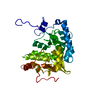
| ||||||||
|---|---|---|---|---|---|---|---|---|---|
| 1 |
| ||||||||
| Unit cell |
|
- Components
Components
| #1: Protein | Mass: 33627.969 Da / Num. of mol.: 1 Source method: isolated from a genetically manipulated source Source: (gene. exp.)   Chromobacterium violaceum (bacteria) / Plasmid: pET-3a / Production host: Chromobacterium violaceum (bacteria) / Plasmid: pET-3a / Production host:   Escherichia coli (E. coli) / Strain (production host): BL21(DE3)pLysS / References: UniProt: P30967, Escherichia coli (E. coli) / Strain (production host): BL21(DE3)pLysS / References: UniProt: P30967,  phenylalanine 4-monooxygenase phenylalanine 4-monooxygenase |
|---|---|
| #2: Water | ChemComp-HOH /  Water Water |
-Experimental details
-Experiment
| Experiment | Method:  X-RAY DIFFRACTION / Number of used crystals: 1 X-RAY DIFFRACTION / Number of used crystals: 1 |
|---|
- Sample preparation
Sample preparation
| Crystal | Density Matthews: 2.15 Å3/Da / Density % sol: 42.7 % | |||||||||||||||||||||||||||||||||||
|---|---|---|---|---|---|---|---|---|---|---|---|---|---|---|---|---|---|---|---|---|---|---|---|---|---|---|---|---|---|---|---|---|---|---|---|---|
Crystal grow | Temperature: 277.15 K / Method: vapor diffusion, hanging drop / pH: 7.5 Details: ammonium sulfate, NaCl, HEPES buffer, pH 7.5, VAPOR DIFFUSION, HANGING DROP, temperature 277.15K | |||||||||||||||||||||||||||||||||||
| Crystal grow | *PLUS Temperature: 4 ℃ | |||||||||||||||||||||||||||||||||||
| Components of the solutions | *PLUS
|
-Data collection
| Diffraction |
| ||||||||||||||||||
|---|---|---|---|---|---|---|---|---|---|---|---|---|---|---|---|---|---|---|---|
| Diffraction source |
| ||||||||||||||||||
| Detector | Type: ADSC QUANTUM 4 / Detector: CCD / Date: Mar 20, 2000 | ||||||||||||||||||
| Radiation |
| ||||||||||||||||||
| Radiation wavelength |
| ||||||||||||||||||
| Reflection | Resolution: 1.74→18.5 Å / Num. all: 30448 / Num. obs: 30448 / % possible obs: 99.8 % / Observed criterion σ(F): 0 / Observed criterion σ(I): 0 / Redundancy: 5.5 % / Rmerge(I) obs: 0.056 / Net I/σ(I): 23.4 | ||||||||||||||||||
| Reflection shell | Resolution: 1.74→1.76 Å / Redundancy: 5.5 % / Rmerge(I) obs: 0.566 / Mean I/σ(I) obs: 2.6 / Num. unique all: 1490 / % possible all: 99.7 | ||||||||||||||||||
| Reflection | *PLUS Highest resolution: 1.73 Å / Lowest resolution: 20 Å / Redundancy: 5-6 / Num. measured all: 124221 / Rmerge(I) obs: 0.056 | ||||||||||||||||||
| Reflection shell | *PLUS Highest resolution: 1.73 Å / % possible obs: 99.7 % / Redundancy: 5-6 / Rmerge(I) obs: 0.566 |
- Processing
Processing
| Software |
| |||||||||||||||||||||||||
|---|---|---|---|---|---|---|---|---|---|---|---|---|---|---|---|---|---|---|---|---|---|---|---|---|---|---|
| Refinement | Method to determine structure : :  MAD / Resolution: 1.74→18.5 Å / Isotropic thermal model: anisotropic / Cross valid method: THROUGHOUT / σ(F): 0 / σ(I): 0 / Stereochemistry target values: Engh & Huber MAD / Resolution: 1.74→18.5 Å / Isotropic thermal model: anisotropic / Cross valid method: THROUGHOUT / σ(F): 0 / σ(I): 0 / Stereochemistry target values: Engh & Huber
| |||||||||||||||||||||||||
| Displacement parameters |
| |||||||||||||||||||||||||
| Refine analyze |
| |||||||||||||||||||||||||
| Refinement step | Cycle: LAST / Resolution: 1.74→18.5 Å
| |||||||||||||||||||||||||
| Refine LS restraints |
| |||||||||||||||||||||||||
| Refinement | *PLUS Highest resolution: 1.73 Å / Lowest resolution: 20 Å / Rfactor Rfree : 0.23 / Rfactor Rwork : 0.23 / Rfactor Rwork : 0.197 : 0.197 | |||||||||||||||||||||||||
| Solvent computation | *PLUS | |||||||||||||||||||||||||
| Displacement parameters | *PLUS | |||||||||||||||||||||||||
| Refine LS restraints | *PLUS
| |||||||||||||||||||||||||
| LS refinement shell | *PLUS Highest resolution: 1.73 Å / Lowest resolution: 1.76 Å |
 Movie
Movie Controller
Controller



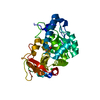

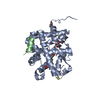




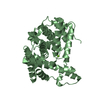

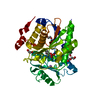

 PDBj
PDBj


